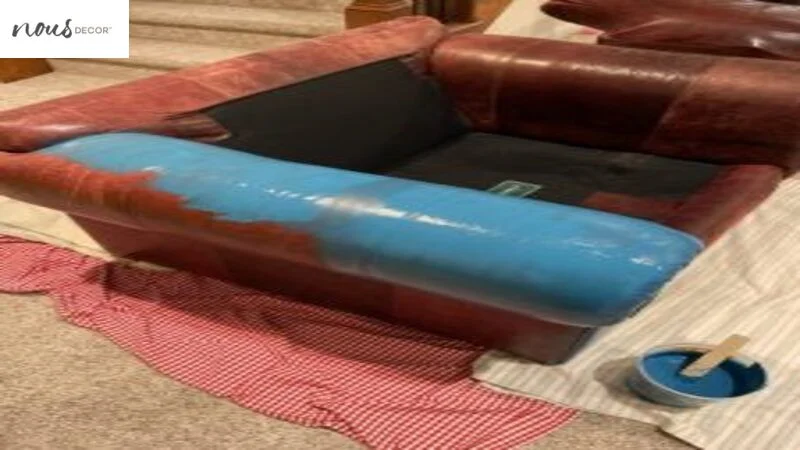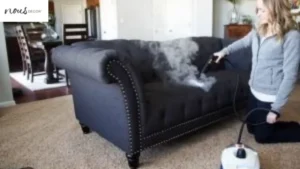Painting leather furniture may seem daunting, but with the right preparation and tools, it can easily be completed in some steps. From selecting the right paint to wearing protective gloves, I’ll walk you through each step so you can tackle this project with confidence.
Let’s get started on How To Paint Sofa Leather with Nousdecor!
Key Takeaways of How To Paint Sofa Leather
- Acrylic paint is best for painting leather furniture.
- Use a preparer or deglazer before painting to help the paint adhere to the leather.
- Apply a sealant after painting to protect the newly painted leather furniture.
- Prepare the workspace by laying down a tarp or drop cloth and using painters tape to line the edges of the furniture.

Preparing the Paint
I need to choose the right paint for my leather furniture, so I’ll pick up some acrylic paint and test different shades on disposable leather items. I’ll avoid household paints and find the perfect shade at a craft store or online.
Before painting, I’ll use a preparer or deglazer with a clean rag. This will help the paint adhere to the leather and may strip the color, but that’s normal. Alcohol-based preparers tend to dry quickly and will protect the newly painted furniture.
To avoid messes, I’ll lay down a tarp and use painters tape around the furniture edges. Wear gloves for protection from the paint and deglazer. Finally, I’ll clean the furniture with warm, soapy water and dry it before applying the preparer.
Also, we must add that using ink to paint your couch is not a good idea. If you did it and regret, however, check out our guide on How To Remove Pen Marks From Leather Sofa now!
Applying the Paint and Sealant
Applying the sealant to protect my newly painted leather furniture is essential for a professional finish. I opt for a matte sealant for a natural look or a gloss sealant for a shiny finish. To ensure even coverage, I use:
- Thin brush strokes:
- Sponge brushes for best results.
- Different sizes of paintbrushes for different products.
- A sponge or sponge brush for some paint products.
- A few paint trays and stir sticks to mix and apply the paint.
- Clean cloth to wipe down the leather surface.
I take the necessary safety precautions by wearing work gloves or rubber gloves, and I keep my hands clean during the process. This ensures a professional, clean finish.
Preparing the Workspace
To protect my floor from potential staining, I lay down a tarp or drop cloth before beginning to paint. The tarp or drop cloth should be large enough to cover the entire area, with enough extra material to cover the sides of the leather furniture.
I then use painters tape to line the edges of the furniture, making sure to apply the tape carefully to avoid any paint leakage. This helps to ensure clean lines and a professional finish.
I also make sure to wear work gloves or rubber gloves while painting. This protects my hands from the paint, deglazer, and sealant, as well as preventing messy hands and skin irritation.
Before painting, I also clean the furniture with a bucket of warm, soapy water and a clean cloth. This removes dirt and debris from crevices and details, and I dry it before applying the preparer or deglazer.
Finally, I find a well-ventilated area to paint in, such as a garage, driveway, or patio. And if your sofa is white and you’re starting to regret painting it, check out our tips for white leather sofa cleaning now for how to repair leather couch!

Safety and Cleanliness Precautions
It is important to take safety and cleanliness precautions while painting leather furniture, such as wearing gloves to protect hands from paint and deglazer and cleaning the furniture before painting.
A good pair of work gloves or rubber gloves should be worn to guard against skin irritation and messy hands. A large tarp or drop cloth should be spread out on the floor to prevent any paint from staining carpets, vinyl, or wood floors. Painters tape should be used to line the edges of the furniture to avoid paint leakage.
For a thorough cleaning, use a bucket of warm, soapy water and a clean cloth to wipe down the leather surface. If necessary, use alcohol and fine-grit sandpaper to strip the protective coating. Test the leather’s readiness by splashing water on it.
| Preparation | Safety and Cleanliness |
|---|---|
| Acrylic paint | Work gloves or rubber gloves |
| Preparer or deglazer | Tarp or drop cloth |
| Sealant | Painters tape |
| Sponge brushes | Bucket of warm, soapy water |
| Paintbrushes | Rubbing alcohol and fine-grit sandpaper |
If your leather-made sofa is a brown one already though, consider checking out our articles on decorating ideas for brown leather sofa and chair colors for brown leather sofa instead!
Frequently Asked Questions
Conclusion
In conclusion, painting leather furniture can be accomplished easily with the right preparation and tools.
Acrylic paint is the best choice, and using a preparer or deglazer before painting ensures good adhesion. Applying a sealant after painting protects the furniture. Remember to protect your workspace with a tarp and painters tape, wear gloves for safety, and clean the furniture beforehand.
By following these steps, you can confidently paint your leather sofa with excellent results. Happy painting! But hey, why paint a sofa when you can just get yourself a new one? Check out our article on top leather sofas for you for the ultimate sofa picks instead!



![Sofa vs Couch: Which Is BEST Choice For You? [2024]](https://nousdecor.com/wp-content/uploads/2021/06/Sofa-vs-Couch-300x197.jpg)


